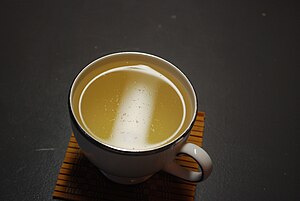White tea
| White tea | |||
|---|---|---|---|
 White Bai Hao Yinzhen tea leaves | |||
| Chinese | 白茶 | ||
| Literal meaning | White tea | ||
| |||
White tea may refer to one of several styles of tea which generally feature young or minimally processed leaves of the Camellia sinensis plant.
Currently there is no generally accepted definition of white tea and very little international agreement; some sources use the term to refer to tea that is merely dried with no additional processing,[1] some to tea made from the buds and immature tea leaves picked shortly before the buds have fully opened and allowed to wither and dry in natural sun,[citation needed] while others include tea buds and very young leaves which have been steamed or fired before drying.[2] Most definitions agree, however, that white tea is not rolled or oxidized[citation needed], resulting in a flavor characterized as "lighter" than most green or traditional black teas.
In spite of its name, sweet, brewed white tea is pale yellow. Its name derives from the fine silvery-white hairs on the unopened buds of the tea plant, which give the plant a whitish appearance. The unopened buds are used for some types of white tea.
It is harvested primarily in China, mostly in the Fujian province,[3] but more recently produced in Eastern Nepal, Taiwan, Thailand, Galle (Southern Sri Lanka) and northeast India.
History[]
What is today known as white tea may have come into creation in the last two centuries; scholars and tea merchants generally disagree as to when the first production of white tea (as it is understood in China today) began. White tea may have first appeared in English publication in 1876, where it was categorized as a black tea, because the leaves are not steamed first as in the making of green tea in order to denature intrinsic oxidative enzymes.[4]
White tea is often sold as Silvery Tip Pekoe in the style of the tea leaf grading system, as well as under the simple designations China White and Fujian White.[3]
Some tea from the related wild Camellia taliensis in Yunnan is made using white tea processing techniques.
Composition[]
White tea, like black and green tea, is made from the Camellia sinensis plant and contains polyphenols, a set of phytonutrients that are thought to be responsible for the health effects of tea.[5][6] Different white teas have different amounts of catechins, a category of polyphenols, and the overall range of concentrations overlaps with that of green tea, meaning that some white teas have the same concentration of polyphenols as some green teas. This may be due to the variety of the tea plant from which the tea was picked, the cultivation technique, and the way in which the tea was processed.[7]
Manufacturing[]
The base process for manufacturing white tea is as follows:
- Fresh tea leaf → withering → drying (air drying, solar drying or mechanical drying) → white tea[8]
White tea belongs to the group of tea that does not require panning, rolling or shaking. However, the selection of raw material in white tea manufacture is extremely stringent; only the plucking of young tea leaves with much fine hair can produce good-quality white tea of a high pekoe (grading) value.[8]

Popular types of white tea[]
- Bai Mudan (white peony)
- Shou Mei tea
- Silver Needle tea
- Tea leaf grading
References[]
- ^ Y. Hilal and U. Engelhardt (2007). "Characterisation of white tea – Comparison to green and black tea" (PDF). www.tu-braunschweig.de. Retrieved 14 April 2019.
- ^ "Tea". oregonstate.edu. 28 April 2014. Retrieved 23 March 2018.
- ^ Jump up to: a b Chow 1990, p. 142
- ^ Hanson 1878, p. 46
- ^ Dulloo, AG; Seydoux, J; Girardier, L; Chantre, P; Vandermander, J (February 2000). "Green tea and thermogenesis: Interactions between catechin-polyphenols, caffeine and sympathetic activity". International Journal of Obesity and Related Metabolic Disorders. 24 (2): 252–258. doi:10.1038/sj.ijo.0801101. PMID 10702779.
- ^ Hursel, R; Westerterp-Plantenga, MS (December 2013). "Catechin- and caffeine-rich teas for control of body weight in humans". American Journal of Clinical Nutrition. 98 (6 Suppl 1): 1682S–1693S. doi:10.3945/ajcn.113.058396. PMID 24172301.
- ^ Unachukwu, UJ; Ahmed, S; Kavalier, A; Lyles, JT (August 2010). "White and green teas (Camellia sinensis var. sinensis): variation in phenolic, methylxanthine, and antioxidant profiles" (PDF). Journal of Food Science. 75 (6): C541–C548. doi:10.1111/j.1750-3841.2010.01705.x. PMID 20722909.
- ^ Jump up to: a b Hui 2004, p. 961
Further reading[]
- Hui, Y. H.; Meunier-Goddik, Lisbeth; Slovejg Hansen, Ase (2004). Handbook of Food and Beverage Fermentation Technology. CRC Press. p. 1000. ISBN 0-203-91355-8.
- Pettigrew, Jane (2004). The Tea Companion: A Connoisseur's Guide. Running Press Book Publishers. p. 129. ISBN 0-7624-2150-9.
- Ho, Chi-Tang (2008). Tea and Tea Products: Chemistry and Health-Promoting Properties. CRC Press. p. 305. ISBN 978-0-8493-8082-2.
- Hanson, Reginald (1878). A Short Account of Tea and the Tea Trade. Whitehead, Morris and Lowe. p. 127. ISBN 1-4021-5748-7.
- White tea
- Chinese tea